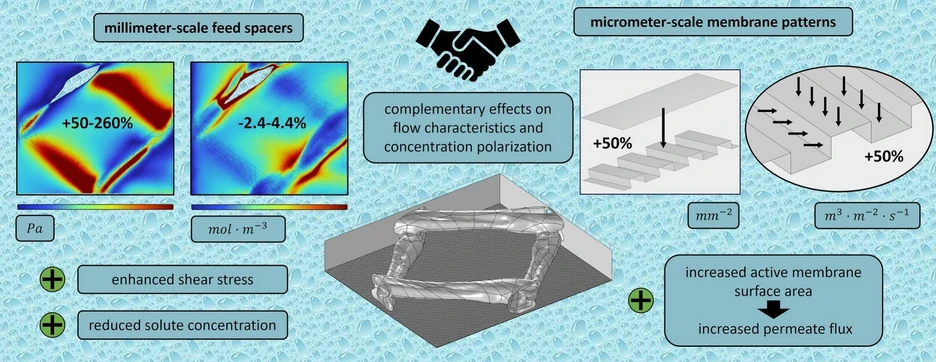Surface-patterning of reverse osmosis membranes is an emerging method for enhancing permeation flux and mitigating membrane fouling. In this study, we numerically investigated flow characteristics and concentration polarization (CP) of these membranes in spacer-filled feed channels representative of commercially applied membrane configurations. Limiting our conceptual study to a rectangular line-and-groove membrane pattern and an industry-typical diamond-shaped spacer, we constructed a multi-scale CFD model encompassing micrometer-scale membrane surface patterns and millimeter-scale feed spacers. Our CFD modeling results at various crossflow velocities showed that the well-known, individual effects of surface-patterned membranes and feed spacers on membrane performance and anti-fouling propensity are perpetuated and complement each other in spacer-pattern assemblies. Feed spacers dominate the macro-scale flow field also in the presence of surface patterns and lead to highly localized distributions of velocity, shear stress, and solute concentration. E.g., shear stress is enhanced by a factor of 1.5 - 3.6 on surface-patterned membranes in spacer-filled vs. spacer-free feed channels. Additionally, surface patterning increases the active membrane surface area and hence the projected permeate flux substantially (by up to 50%) compared to flat membranes, in spacer-filled and spacer-free channels alike. However, as pattern valleys show increased solute concentration, overall CP on surface-patterned membranes is higher than on flat membranes, even in spacer-filled channels. We recommend further numerical optimization of multi-scale feed channel geometry, encompassing surface patterns and feed spacers, as well as long-term filtration and fouling tests to experimentally investigate the effects of surface-patterned membranes in spacer-filled feed channels.
